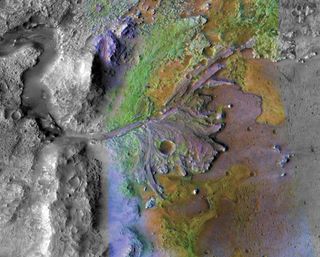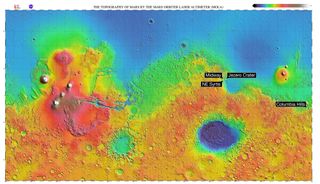We now know where NASA's life-hunting, sample-caching Mars rover will touch down a few years from now.
The car-size Mars 2020 rover will explore the 28-mile-wide (45 kilometers) Jezero Crater, which hosted a deep lake in the ancient past, NASA officials announced today (Nov. 19). If current schedules hold, the six-wheeled robot will launch on July 17, 2020, and touch down on Feb. 18, 2021.
"The landing site in Jezero Crater offers geologically rich terrain, with landforms reaching as far back as 3.6 billion years old, that could potentially answer important questions in planetary evolution and astrobiology," Thomas Zurbuchen, associate administrator for NASA’s Science Mission Directorate, said in a statement today. [NASA's Mars Rover 2020 Mission in Pictures (Gallery)]
"Getting samples from this unique area will revolutionize how we think about Mars and its ability to harbor life," he added.
There is no sample-retrieval mission currently on NASA's books, but the agency hopes to go grab the collected material in the late 2020s, Zurbuchen said during a news conference today. Studying such samples in the well-equipped labs here on Earth could lead to discoveries impossible for a robot to make all by itself on the Martian surface, he added.

The body of Mars 2020 is based heavily on NASA's Curiosity rover, which has been exploring the Red Planet's Gale Crater since August 2012. But whereas Curiosity's main task involves querying Mars' past potential to host life, the new rover will seek out evidence of organisms that may have lived billions of years ago, when the Martian surface was relatively warm and wet.
Jezero Crater will be a great place to do this work, Zurbuchen and other NASA officials said during today's news conference. Scientists believe an 820-foot-deep (250 meters) lake filled the crater at some point in the period from about 3.9 billion to 3.5 billion years ago. Jezero also sports a prominent river delta, where water flowing through this system deposited lots of sediment over the eons.
Get the Space.com Newsletter
Breaking space news, the latest updates on rocket launches, skywatching events and more!
"A delta is extremely good at preserving biosignatures, [be they] evidence of life that might have existed in the lake water, or at the interface between the sediment and the lake water, or, possibly, things that lived in the headwaters region that were swept in by the river and deposited in the delta," Mars 2020 project scientist Ken Farley, of NASA's Jet Propulsion Laboratory in Pasadena, California, said during today's news conference. [Photos: Ancient Mars Lake Could Have Supported Life]

Jezero, which lies about 18 degrees north of the Martian equator, also boasts substantial geological diversity and complexity, Farley said. So, Mars 2020 will be able to study lots of different kinds of rock for clues about the planet's evolution and past life-hosting potential.
The rover will use seven different science instruments to do its various work on the Red Planet. This package includes high-resolution cameras, ground-penetrating radar, several different spectrometers and a weather station. Mars 2020 also carries gear that will generate oxygen from the thin, carbon-dioxide-dominated air, demonstrating technology that could aid future human exploration of the Red Planet.
There's another technology demonstrator on board as well — a solar-powered drone that will fly scouting sorties to help Mars 2020 pick interesting study targets.
It took about five years for NASA to land on Jezero Crater as Mars 2020's touchdown site. The agency had recently narrowed the list down to four finalists — Jezero, Midway and Northeast Syrtis, which are all close to each other, and the near-equatorial Columbia Hills site, which was explored by NASA's Spirit rover a decade or so ago.
It's possible that Mars 2020 could make its way over to Midway at some point during a potential extended mission, Zurbuchen said today. But he stressed that the focus will be on Jezero through the primary mission.
Landing safely inside Jezero Crater won't be a gimme. The terrain is complex, with boulders and sand dunes to avoid. Touching down directly on the river delta is also not advisable, mission team members said today.
But the team is confident that Mars 2020's entry, descent and landing (EDL) system is up to the challenge. Like Curiosity, the new rover will land with the aid of a rocket-powered sky crane, which will lower Mars 2020 to the surface on cables. This sky crane will feature a "terrain relative navigation" (TRN) capability, which will allow it to avoid hazardous areas during EDL, NASA officials said.
"Nothing has been more difficult in robotic planetary exploration than landing on Mars," Zurbuchen said in the same statement. "The Mars 2020 engineering team has done a tremendous amount of work to prepare us for this decision. The team will continue their work to truly understand the TRN system and the risks involved, and we will review the findings independently to reassure we have maximized our chances for success."
The total mission cost of Mars 2020 is expected to be a bit less than Curiosity's $2.5 billion price tag, Zurbuchen said today.
Today's announcement comes just a week before NASA's InSight lander attempts its own Mars touchdown. InSight will settle safely onto a Red Planet plain called Elysium Planitia on the afternoon of Nov. 26, if all goes according to plan, then begin investigating Mars' interior structure and composition.
The European Space Agency and Russia also jointly plan to launch a life-hunting Mars rover in 2020. Their ExoMars rover will likely touch down on the plain Oxia Planum, which lies just north of the Red Planet's equator. But official confirmation of the ExoMars landing-site selection isn't expected until the middle of next year.
Mike Wall's book about the search for alien life, "Out There" (Grand Central Publishing, 2018; illustrated by Karl Tate) is out now. Follow him on Twitter @michaeldwall. Follow us @Spacedotcom or Facebook. Originally published on Space.com.
Join our Space Forums to keep talking space on the latest missions, night sky and more! And if you have a news tip, correction or comment, let us know at: community@space.com.

Michael Wall is a Senior Space Writer with Space.com and joined the team in 2010. He primarily covers exoplanets, spaceflight and military space, but has been known to dabble in the space art beat. His book about the search for alien life, "Out There," was published on Nov. 13, 2018. Before becoming a science writer, Michael worked as a herpetologist and wildlife biologist. He has a Ph.D. in evolutionary biology from the University of Sydney, Australia, a bachelor's degree from the University of Arizona, and a graduate certificate in science writing from the University of California, Santa Cruz. To find out what his latest project is, you can follow Michael on Twitter.